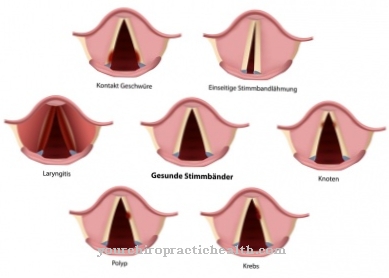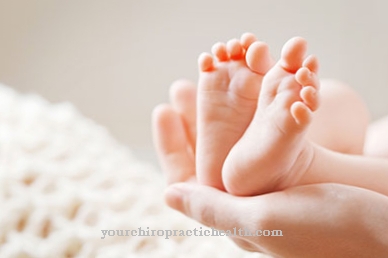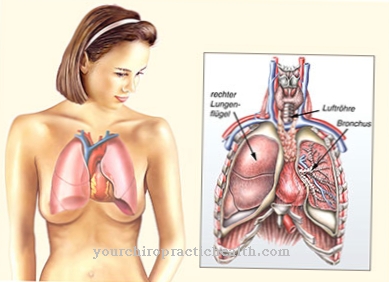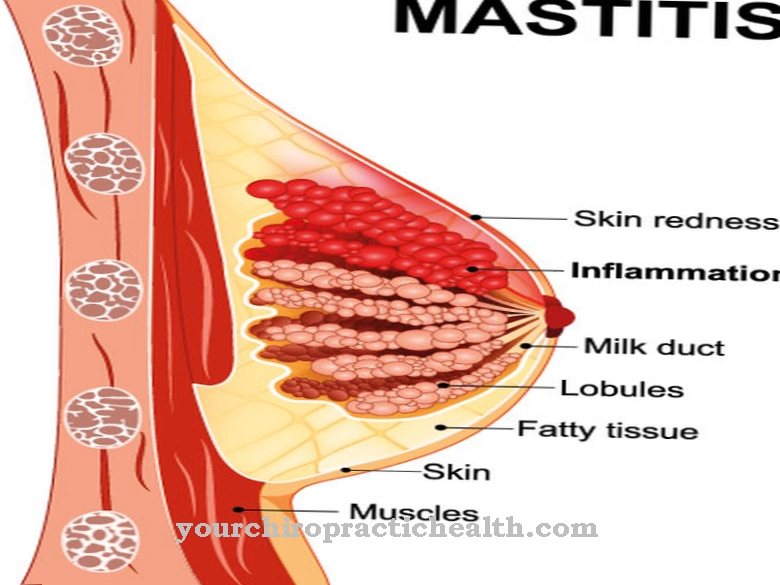A Umbilical hernia, in technical language Umbilical hernia called, denotes a crack or opening in the abdominal wall through which the intestines can visibly exit to the front. It often affects babies, but also middle-aged women. Experts advise operating umbilical hernias in adults as a matter of principle.
What is an umbilical hernia?

Under a Umbilical hernia Doctors don't understand a break in the strict sense of the word. Rather, it is a tear or hole in the abdominal wall, which allows the intestines to step forward.
This is often done by pressing hard or by pressure that makes the abdominal wall give way. The intestines are then only held inside by the skin. An umbilical hernia is visually recognizable by a clearly visible bulge in the area of the umbilicus, the so-called hernial sac.
Umbilical hernias are particularly common in infants. Adults can also be affected, especially women between 50 and 70 years of age.
causes
A Umbilical hernia can arise for different reasons. Basically, a weakness of the abdominal wall in the area of the former umbilical cord triggers the leakage of the viscera.
This weakness is genetic. It can either be innate or develop slowly in the course of life. Often the abdominal wall does not grow together properly after birth, which is the reason for umbilical hernias frequently occurring in infants.
If an adult has an umbilical hernia, the weakness of the abdominal wall has developed over the years. Then it is enough to put a lot of strain on the abdominal muscles or to press hard during pregnancy or constipation to cause a tear in the abdominal wall.
Symptoms, ailments & signs
An umbilical hernia is first noticeable as a swelling or bulging in the area of the umbilicus. The swelling usually does not cause any symptoms at the beginning. Depending on whether parts of the intestine are pinched, pulling or burning may occur. Signs of inflammation such as hard or reddened areas are also characteristic.
The pain occurs mainly when bending, pressing, coughing or lifting heavy loads. The intestine can rarely get stuck in the hernial sac, resulting in severe pain. The affected intestinal region is also no longer adequately supplied with blood and oxygen, which can lead to necrosis. Such a severe course is also manifested by blood in the stool and other complaints when defecating.
In addition, colic, fever, nausea and vomiting occur in some cases. Entrapment of the bowel occurs in four out of every hundred people. In the remaining cases, the umbilical hernia is symptom-free and is only detected as part of a routine examination. If the umbilical hernia is not treated, the symptoms increase.
Eventually, perforation can develop, which can lead to internal bleeding, infection, and other life-threatening complications. With early diagnosis and treatment, the umbilical hernia symptoms will go away completely within a few weeks.
Diagnosis & course
If a Umbilical hernia is present, the attending physician can determine primarily by performing an ultrasound examination.
This way he can tell if the bowels have changed position. He can also try to push it back into the abdominal cavity with light pressure. If this is not possible or if you experience pain, the bowels may be pinched.
Then a quick operation is necessary. In principle, an umbilical hernia does not necessarily have to be treated, because it does not pose an immediate health risk if the organs are not blocked. However, those affected must be aware that it will not heal on its own - this only happens in small children up to three years of age.
Complications
An umbilical hernia usually heals by itself during the first two years of life. At an older age, serious, sometimes even life-threatening complications can be expected from an umbilical hernia, especially if it is not treated promptly. Parts of the intestine can become trapped in the hernial sac, which is accompanied by very severe, colicky pain. The abdomen becomes very sensitive to pressure; even light touches during the examination can cause extreme pain in the patient.
Larger umbilical hernias with parts of the large or small intestine in the hernial sac can cause diarrhea or constipation, and sometimes patients also observe blood in the stool. In addition, there is the risk that the trapped intestinal parts are no longer supplied with sufficient blood and that they tend to shrink. If the protective abdominal wall is missing, dangerous injuries to the intestine can occur, which often require emergency surgery.
Other possible complications are high fever combined with nausea and vomiting. When trapped, sweats, excruciating thirst, palpitations and a sharp drop in blood pressure often occur.
If treatment is delayed, there is also the risk that the contents of the hernia will ignite or stick to the environment, so that the hernia can no longer be reduced. If emergency surgery is necessary due to late treatment, the risk of pulmonary embolism also increases.
When should you go to the doctor?
Irregularities and disorders in the area of the navel should be presented to a doctor. If there is swelling, discoloration of the skin or deformation, action is required. A doctor visit is necessary if there is a bulging or lump formation on the navel. If the swelling increases in size, a doctor should be consulted as soon as possible.
If pain occurs, the person concerned needs help. Pain reliever medication should not be taken and should only be done in consultation with a doctor. There are risks and side effects about which the person affected must be informed and educated. Bleeding or loss of other body fluids from the navel is a cause for concern. You must be presented to a doctor so that the cause can be clarified and a treatment plan can be drawn up. If there is blood in the stool or in the urine, these symptoms should be discussed with a doctor.
A general malaise, nausea, indigestion, irregular heartbeat or an internal weakness are signs of a health impairment. If the symptoms persist or if they show increasing intensity, a doctor is required. If you have fever, convulsions or colic, you should see a doctor immediately. Since an umbilical hernia can lead to life-threatening developments, a medical check-up should take place as soon as the first signs appear.
Treatment & Therapy
The attending physician clearly has one Umbilical hernia diagnosed, it must be considered whether and how it should be treated. In small children, the fracture is usually not treated, because it usually heals by itself without complications up to about three years of age.
The abdomen may be bandaged to aid this process. If an adult has an umbilical hernia, there is no chance of self-healing. Experts recommend having the hernia treated surgically in order to minimize the risk of life-threatening organ jamming.
Such a surgical procedure can even be carried out on an outpatient basis; the patient can usually leave the clinic after a few hours.
There are basically two surgical methods to choose from, which differ in the size of the umbilical hernia in the individual case. If there are tears up to about 2 cm, the abdominal wall is sewn with a solid seam. Only a very small surgical scar remains here.
In the case of larger cracks or holes, the abdominal wall is additionally reinforced with a plastic net so that no further or repeated umbilical hernias can occur. If the procedure goes without complications, the patient can be active again after approx. 14 days without hesitation.
Outlook & forecast
In infants, the prognosis for healing is very good. In 90 percent of all cases, umbilical hernias heal in babies' first year of life without complications. Sometimes the parents need a little more patience, as the complete closure of the abdominal wall can take up to 3 years of age. If the umbilical hernia is painless and an ultrasound does not show any abnormalities, the conditions in children are good for self-healing.
Adults, on the other hand, have to have an operation for an umbilical hernia sooner or later to avoid complications. The fully grown body no longer closes the holes and cracks on its own. Self-healing is almost impossible. In an operation, the hole is covered with a plastic mesh and healing is accelerated. Complications rarely arise after such an operation. Some patients develop severe scarring. At the treated area, there is an increased risk of breakage due to heavy stress (heavy cough, intense exercise or heavy lifting). Physical activity should be restricted as long as the tear is not treated. The risk of the umbilical hernia becoming larger and the operation more difficult is great.
prevention
There a Umbilical hernia caused by a weakness in the abdominal wall, it cannot be prevented directly. If an umbilical hernia is suspected, a doctor should be consulted in order to rule out an organ jamming. Even if small children usually do not need treatment, they should always be presented to the doctor if there is an umbilical hernia. In this way, possible complications can be avoided and healing can be supported.
Aftercare
The aftercare aims, among other things, to prevent recurrence of complaints. Doctors therefore rely on close monitoring of the progress. In the case of an umbilical hernia, external circumstances lead to the disease. The patient can only try to avoid this. Preventive measures include not lifting heavy loads and reducing excess weight.
Strengthening the abdominal muscles has also been proven to prevent a new umbilical hernia. It is the patient's responsibility to implement these precautions. As part of the initial therapy, the doctor may provide information about suitable preventive measures. An umbilical hernia always heals completely.
No treatment is even required in young children and expectant mothers. They usually heal spontaneously after a short time. Due to the freedom from symptoms, there is no relevance for follow-up care at the end of therapy. Neither long-term treatment nor everyday support are necessary.
The patient can leave the hospital after just a few days. In the case of an outpatient procedure, recovery takes place at home. As part of a final examination, the doctor palpates the affected area with his hands. An ultrasound scan may show that everything is healing as expected.
You can do that yourself
Since the umbilical hernia can often be traced back to a weakness of the connective tissue in the abdomen, the affected patient can do little about it. Umbilical hernias are relatively common in children and are usually harmless. Since umbilical hernias in children very often resolve on their own, no therapeutic measures are usually taken. Bandaging the core of the body can promote the healing process, but is rarely required. The break point, which can be seen as a protuberance under the skin, should be observed by the child's caregiver. If the area changes, if the child is in pain or if the skin turns bluish, a doctor must be consulted immediately.
Umbilical hernias also occasionally occur during pregnancy, but these also very often resolve on their own after birth. Pregnancy exercises and avoiding excessive weight gain can lower the risk of an umbilical hernia in pregnant women.
Umbilical hernias in adults who are not expecting a child are often the result of improper physical exertion or severe obesity. They are usually not dangerous, but should be treated surgically to prevent life-threatening organ jamming, which occurs much more frequently in adults than in children. Anyone suffering from an acute umbilical hernia should, above all, refrain from lifting heavy so as not to enlarge the fracture site. Even after a successful operation, heavy lifting should be avoided so that another umbilical hernia does not occur. If you are overweight, losing weight will lower the risk of an umbilical hernia.




.jpg)



.jpg)



















